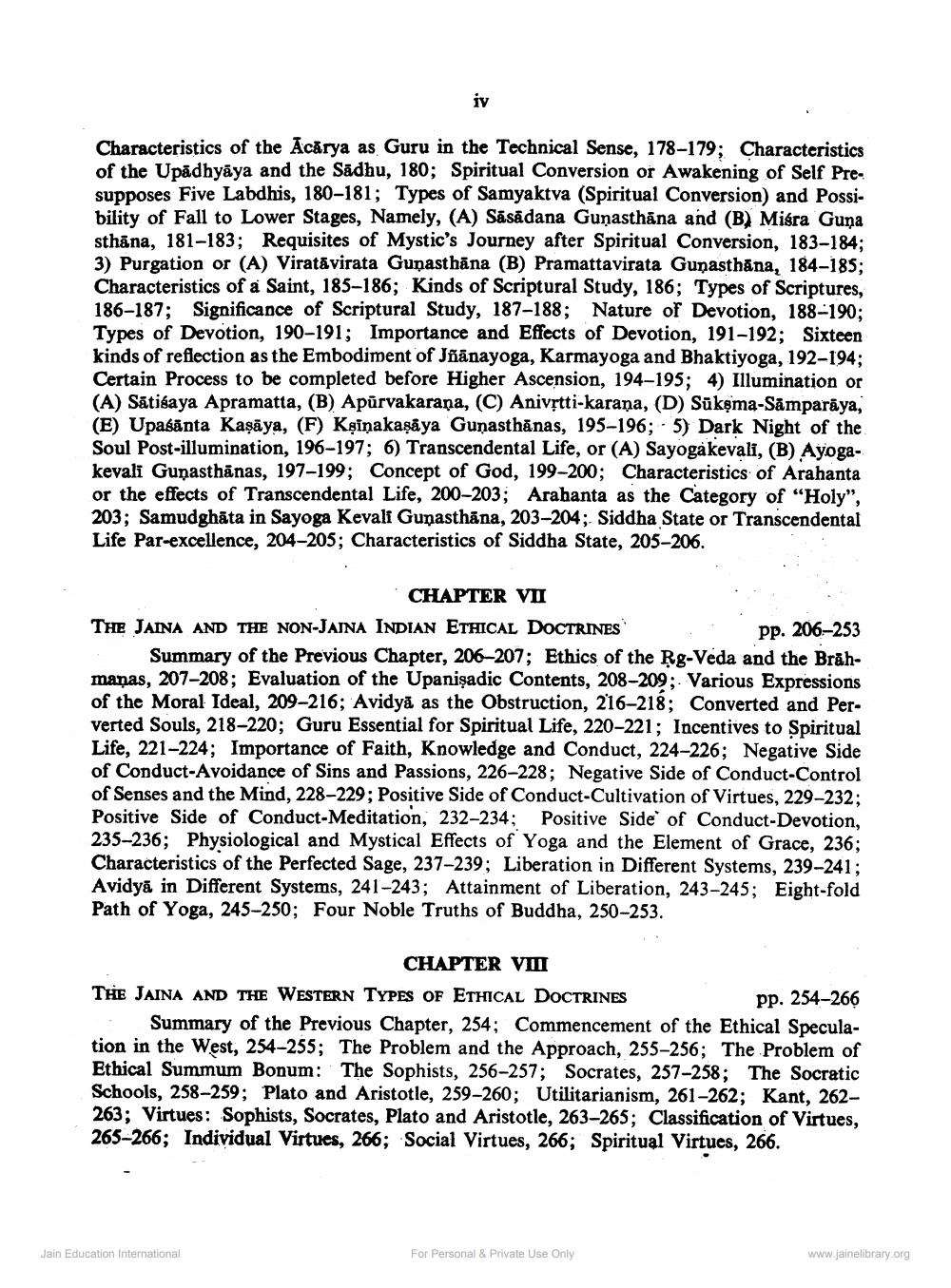________________
Sasādana Gunasthan conversion) and
Requisites of Mystic
Characteristics of the Acarya as Guru in the Technical Sense, 178-179; Characteristics of the Upadhyāya and the Sadhu, 180; Spiritual Conversion or Awakening of Self Presupposes Five Labdhis, 180-181; Types of Samyaktva (Spiritual Conversion) and Possibility of Fall to Lower Stages, Namely, (A) Sāsādana Gunasthāna and (B) Misra Guna sthāna, 181-183; Requisites of Mystic's Journey after Spiritual Conversion, 183-184; 3) Purgation or (A) Viratăvirata Gunasthāna (B) Pramattavirata Gunasthāna, 184-185; Characteristics of a Saint, 185-186; Kinds of Scriptural Study, 186; Types of Scriptures, 186-187; Significance of Scriptural Study, 187-188; Nature of Devotion, 188-190; Types of Devotion, 190-191; Importance and Effects of Devotion, 191-192; Sixteen kinds of reflection as the Embodiment of Jñānayoga, Karmayoga and Bhaktiyoga, 192-194; Certain Process to be completed before Higher Ascension, 194–195; 4) Illumination or (A) Sātisaya Apramatta, (B) Apūrvakarana, (C) Anivstti-karaņa, (D) Sūkņma-Samparāya, (E) Upasānta Kaşāya, (F) Kșiņakaşaya Gunasthānas, 195–196; 5) Dark Night of the Soul Post-illumination, 196-197; 6) Transcendental Life, or (A) Sayogakevali, (B) Ayogakevali Gunasthānas, 197-199; Concept of God, 199-200; Characteristics of Arahanta or the effects of Transcendental Life, 200-203; Arahanta as the Category of “Holy", 203; Samudghāta in Sayoga Kevali Gunasthāna, 203-204; Siddha State or Transcendental Life Par-excellence, 204-205; Characteristics of Siddha State, 205–206.
CHAPTER VII THE JAINA AND THE NON-JAINA INDIAN ETHICAL DOCTRINES
pp. 206–253 Summary of the Previous Chapter, 206,207; Ethics of the Rg-Veda and the Brāhmaņas, 207-208; Evaluation of the Upanişadic Contents, 208-209; Various Expressions of the Moral Ideal, 209-216; Avidyā as the Obstruction, 216-218; Converted and Per. verted Souls, 218-220; Guru Essential for Spiritual Life, 220-221; Incentives to Spiritual Life, 221-224; Importance of Faith, Knowledge and Conduct, 224-226; Negative Side of Conduct-Avoidance of Sins and Passions, 226-228; Negative side of Conduct-Control of Senses and the Mind, 228-229; Positive side of Conduct-Cultivation of Virtues, 229-232; Positive side of Conduct-Meditation, 232-234; Positive side of Conduct-Devotion, 235-236; Physiological and Mystical Effects of Yoga and the Element of Grace, 236; Characteristics of the Perfected Sage, 237-239; Liberation in Different Systems, 239-241; Avidyā in Different Systems, 241-243; Attainment of Liberation, 243-245; Eight-fold Path of Yoga, 245–250; Four Noble Truths of Buddha, 250-253.
CHAPTER VIII THE JAINA AND THE WESTERN TYPES OF ETHICAL DOCTRINES
pp. 254–266 • Summary of the Previous Chapter, 254; Commencement of the Ethical Speculation in the West, 254-255; The Problem and the Approach, 255-256; The Problem of Ethical Summum Bonum: The Sophists, 256-257; Socrates, 257-258; The Socratic Schools, 258-259; Plato and Aristotle, 259-260; Utilitarianism, 261-262; Kant, 262263; Virtues: Sophists, Socrates, Plato and Aristotle, 263-265; Classification of Virtues, 265-266; Individual Virtues, 266; Social Virtues, 266; Spiritual Virtues, 266.
Jain Education International
For Personal & Private Use Only
www.jainelibrary.org




